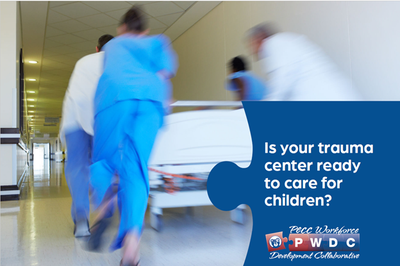PRESS RELEASE: Raising the bar for pediatric trauma care
- Published November 23, 2021

Pediatric readiness assessment to be required for trauma center verification
For immediate release
Contact: km@emscimprovement.center
(NOV. 23, Austin, Texas) More children die of injury each year than from all other causes combined. But only 57% of children across the United States have feasible access to a pediatric trauma center--even though kids, because of their unique anatomies and physiologies, require specialized care.
Experts hope to bridge this gap through new pediatric standards for all verified trauma centers, both adult and pediatric, including one related to the National Pediatric Readiness Project, the flagship initiative of the federally funded Emergency Medical Services for Children (EMSC) Program. The project is jointly led by EMSC and the American Academy of Pediatrics, the American College of Emergency Physicians, and the Emergency Nurses Association.
The new standards were announced Nov. 17 during the 2021 American College of Surgeons (ACS) Trauma Quality Improvement Program annual conference. Trauma center verification is ACS’s evaluation process to assess and improve trauma care nationwide. The process is voluntary, and verification lasts for three years.
“The new standard on pediatric readiness is the result of years of close collaboration between the EMSC Program and the ACS Committee on Trauma,” says Aaron Jensen, MD, MEd, MS, Trauma Co-Lead for the EMSC Program’s Innovation and Improvement Center. “We are grateful to the College for their recognition of the importance of pediatric readiness and are excited to help raise the bar for the initial post-injury care of children nationwide.”
The new pediatric readiness standard will require all trauma centers to participate in the National Pediatric Readiness Project assessment. The assessment, which is self-guided, covers six focus areas related to improving pediatric care infrastructure: administration and coordination of care for children; personnel competencies; quality improvement; pediatric-specific policies; equipment; and pediatric patient safety. Upon completing the assessment, participants receive a pediatric readiness score and a gap report.
If any gaps are identified, the new standard will require that trauma centers develop a plan to address them.
“The best way to prepare for the new pediatric standards is to identify a team member who can serve in the role of a pediatric emergency care coordinator or PECC,” says Kate Remick, MD, Co-Director of the EMSC Innovation and Improvement Center and the National Pediatric Readiness Project. “Research shows that having a PECC improves pediatric readiness scores by 16 points, and having high pediatric readiness scores is associated with as much as a four-fold lower rate of mortality in children.”
The standards are anticipated to be published in March 2022 in the seventh edition of “Resources for Optimal Care of the Injured Patient,” the guidebook for trauma center improvement and verification.
To help trauma centers prepare for the new standard, the EMSC Innovation and Improvement Center is holding a Trauma Improvement Sprint on Feb. 23 and March 2 as part of its PECC Workforce Development Collaborative, which began in September. A PECC can be any physician, nurse, or clinical team member; previous pediatric experience is not required.
“As a nurse in a mixed adult and pediatric ED, I would highly recommend joining the collaborative to improve pediatric care in your facility, ” says Aspen Di Ioli, RN, a participant and PECC at Pomona Valley Hospital Medical Center. “I have learned something new at every session. It’s amazing to network with peds-specific nurses and hospitals and have access to their resources.”
Register for the sprint here. To learn more about trauma center verification, visit https://www.facs.org. To learn more about pediatric readiness and access related resources and tools, visit https://emscimprovement.center/.
###
About the EMSC Innovation and Improvement Center
Formed in 2016, the Emergency Medical Services for Children Innovation and Improvement Center (EIIC) leverages quality improvement science, the experiential knowledge of its co-lead organizations—The University of Texas at Austin Dell Medical School and University Hospitals Rainbow Babies and Children's as well as partners at Yale University, Baylor College of Medicine and The Lundquist Institute—and the expertise of multiple professional societies and federal organizations to improve health care outcomes for children in emergency settings. Learn more at: https://emscimprovement.center.
The EMSC Innovation and Improvement Center is supported by the Health Resources and Services Administration (HRSA) of the U.S. Department of Health and Human Services (HHS) as part of an award (U07MC37471) totaling $3M with 0 percent financed with nongovernmental sources. The contents are those of the author(s) and do not necessarily represent the official views of, nor an endorsement, by HRSA, HHS or the U.S. Government.